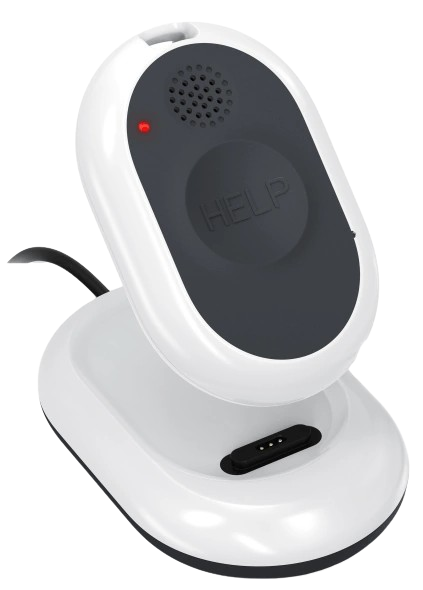Prince Edward Island Lone Worker
Our Safety Policy Guide For Lone Workers In Prince Edward Island
Across Canada, federal and provincial/territorial governments share responsibilities for laws and workplace policies. In Prince Edward Island, employers must comply with the federal Occupational Health and Safety Code while also considering localized recommendations for lone workers.
This page offers insights into how employers in Prince Edward Island can address the specific needs of lone workers, drawing on both federal and provincial guidance.
On This Page
Our Guide To Lone Worker Safety Policy And Legislation In Prince Edward Island
In Prince Edward Island, working alone can create hazardous conditions, and it is vital for employers to follow both provincial and federal safety regulations. These laws are designed to mitigate risks for lone workers.
On this page, we will cover the critical aspects of employing lone workers in Prince Edward Island, including guidance on meeting the hazard assessment and control standards outlined in the Occupational Health & Safety Code (OHS).
How Prince Edward Island Defines A Lone Worker
Prince Edward Island defines a "lone worker" as an individual working at a workplace as the sole worker of the employer, in situations where assistance is not readily available in the event of an injury, illness, or emergency. This includes cases where a call for help may not be noticed or responded to, and the worker's absence may go unnoticed for a significant period.
Employing A Lone Worker In Prince Edward Island
Prince Edward Island policies and guidelines recommend employers to conduct thorough risk assessment to identify potential hazards and determine the level of protection needed for lone workers based on the nature of their tasks and environment. Best practices include providing effective training on risk recognition, establishing a communication plan, and creating procedures for tasks with higher risks, such as working with hazardous machinery or in isolated areas.
Employers are advised to minimize risks by rescheduling tasks to avoid lone work whenever possible, using buddy systems or limiting access through physical controls like locked doors. Workers should be trained in emergency response and violence prevention, with procedures checked and updated regularly to ensure they remain effective.
Learn How You Can Protect Your Employees With Loneworker.com

With Loneworker.com you can be equipped with the knowledge and the means to protect your employees and protect your business. Contact us today to learn more about how Loneworker.com can protect you and your employees.
How The Safe Lone Worker App Can Protect Prince Edward Island Lone Workers And Employers
An important part of keeping your lone workers safe is providing quick and easy communication and monitoring in the event of an emergency.
With the Safe Lone Worker App, you can easily monitor your employees' while they are carrying out their responsibilities, even if they are travelling alone. The app works in tandem with a man down alert button that can be pressed in the event of an emergency. If the button is pushed, the lone worker will be immediately put into contact with a monitoring center that can send help immediately and contact the employer.
Prince Edward Island Lone Worker Policies
The content below has been included as a direct reference for lone worker policies as provided by Prince Edward Island. This content has been included to serve as more detailed information and an easy reference point. This information is provided for your convenience, but should not be taken as legal advice. We encourage you to conduct your own research into the laws and regulations of your jurisdiction before making any decisions.
Working Alone Definition
“working alone” means a worker working at a workplace who is the only worker of the employer at that workplace, in circumstances where assistance is not readily available to the worker in the event of injury, ill health or emergency.
A worker can be considered to be working alone if there is a reasonable expectation that a call for assistance will not or cannot be responded to and the worker’s absence may not be noticed for some time. Risks to workers may be higher when they are working alone. A fall, exposure to dangerous chemicals or an assault can have very different consequences if a worker is alone than if the victim has co-workers or capable assistants in the immediate vicinity.
The intent of the working alone regulations is to set a minimum standard for the safety of workers who work alone, particularly those who have a high degree of risk inherent in their work. The requirements for the safety of an office worker working alone will be very different from the requirements for a late night convenience store worker or a home care worker working alone with a client with a history of unpredictable behavior. The degree of risk will determine the level of protection the worker needs.
The best work alone practices include worker training on recognizing risks and an effective communication plan.
Common Work Alone Situations Where Workers Are At Risk
Workers who :
- handle cash (such as convenience store clerks, retail and food outlet workers and taxi drivers)
- meet clients out of office (such as home care workers, social service workers and bylaw officers)
- work outside of normal working hours ( such as convenience store clerks, cleaners, security, special production)
- do hazardous work with no regular interaction with other people (such as forestry workers or night cleaners in a plant)
- are at risk of violent attack because they are isolated from worker or public view (such as security guards, custodians )
- work away from their fixed base ( such as construction workers, forestry workers, postal staff, engineers)
The potential for violence or serious consequences from assault is higher when workers are alone.
For this reason many of the procedures developed for violence prevention will apply to working alone situations. The Guide to the Prevention of Workplace Violence on the WCB website (www.wcb.pe.ca) will provide more details.
Learn How The Lone Worker Monitoring Device Works.

By using a Safe Lone Worker Man Down alert you can monitoring your employees and keep them safe even while they are travelling or working on their own.
Our devices are equipped with cellular and GPS technology to provide service all across Canada and the United States of America.
Contact us today to get your Safe Lone Worker Man Down Alerts for you and your business.
Procedures for Safe Work - Section 53.2(1)
Section 53.2 (1) requires that procedures be developed. 53.2 (2) (d) requires that risks be identified in those procedures. To identify risks, a risk assessment must be done. This will clarify the potential for an accident and the level and type of precautions necessary.
Answer the questions below in this sample risk assessment to determine where your risks are and what you can do to minimize them. Remember to consult with workers when looking for solutions. Their contributions will make solutions workable. When workers have input into their working alone procedures, they take ownership and this will increase the likelihood that the procedures will be followed.
Risk Assessment
1. The first step is to review your work history.
- Have there been incidents with workers working alone?
- How serious were they?
- Is there a pattern to the incidents? (location, time of day, type of work?)
- Have your safety committee or safety representative or a supervisor speak to all the workers who work alone to ask if they have had any near misses and what they see as a potential risk.
- Ask everybody and document the responses. Be positive in your approach and remember the workplace will benefit from this information.
- Are there policies in place?
- Are all workers aware of the policies? Are they followed and monitored?
2. Look at workplaces similar to yours and determine what incidents have occurred there:
- If you have a head office or an association, find out if there is any information available on incidents and what is recommended.
- Where there is a risk of violence or robbery, local police or security companies may have information on areas or times of high risk as well as solutions.
3. Consider your physical work environment and tasks being performed. Answer the following questions:
- Is the worker working in or around potentially dangerous machinery or areas? Examples would include lathes, saws, mobile equipment, or confined spaces.
- How great is the risk of injury from the machinery or equipment?
- Are there workers who work in remote locations in your workplace such as cold storage, maintenance room, boiler room? How long would it be before someone noticed their absence if they were injured?
- Is there a risk of violence or robbery? Review the Guide to Workplace Violence for suggestions of a risk assessment in this situation.
- Does their geographic location create a potential for assault?
- Does the worker handle cash? Do you have surveillance in place for these workers?
- Do you have policies or practices that minimize their risk?
- Does the work involve clients who may be intoxicated?
- Does the work involve unpredictable clients or clients who may be confused?
- Is the work done late at night? Do workers leave alone?
- Does the worker work with the general public while alone?
- Will workers be handling controlled products while they are alone?
- Is there a requirement for personal protective equipment such as respiratory protection for these substances that would indicate a higher risk?
- Is access to the work site controlled? This can help or create challenges.
- Is there a risk of a fall? Will workers be climbing or working from heights?
4. Next consider the administrative practices around your work. This is the way the work is managed to reduce risk.
- How long are workers alone?
- Is there a means of communication available now such as a portable phone, personal alarm system, or emergency call button?
- Will the communication system work in all circumstances?
- Will a call-in be adequate?
- What will be done if there is no response?
- Would a buddy system work in your work environment where lone workers could call each other?
- How familiar are the workers with the workplace?
- How experienced are your workers?
- How well trained are they to handle an emergency?
- Were recommendations made from any previous incidents around working alone? Were they implemented? Did they work?
- Do workers need to work alone? Can things be rescheduled to reduce the need for lone workers?
- Can a list of higher risk tasks that are not to be done while worker is alone be created, e.g. not to work at heights, with power lines or hazardous materials?
- Is cash kept to a minimum and is money locked in a safe or taken away while workers are alone?
- Are there medications on site that would attract a robber, and if so are the medications locked up?
- In the service sector can you lock the doors and just use a service window or drive through while you have a lone worker?
- Are there temporary risks that may require back up only for the duration of the task or while a particular client is being cared for?
- Do all your workers know all the relevant procedures?
- Is there a system in place to ensure working alone procedures are being followed?
- Ask workers what they do now - formally or informally - to reduce hazards.
- Look at the risk areas you have identified.
- Consider ways to eliminate or minimize risks where possible. Identify tasks that can be done while others are present. Inform staff on tasks to avoid while alone.
- Find a way to reduce the risk where possible, e.g. lock the doors and limit access.
- Develop a written work procedure for each risk area. Remember to use information on risks from workers to develop procedures.
- Train all workers including supervisors, part time and casual workers on working alone procedures.
- Check to be sure working alone procedures are working and are being followed.
Your risk assessment information will determine what procedures you need to develop.
References
Safety Maters @ Work Workers Compensation Board of PEI. Guide To Working Alone Regulations 2023.
Government of Canada, Canadian Centre for Occupational Health and Safety. Working Alone - General. 10 May 2024.
Loneworker.com is an aggregate resource and is not directly affiliated with government policies, legislation, or guidelines. Our site is intended to gather and display information for your use, but you are encouraged to conduct your own research.
Prince Edward Island Lone Worker Resources

Workers Compensation Board of PEI
WCB Office:
- 902-368-5680
Toll free (Atlantic Canada):
- 1-800-237-5049
OHS Division
- 902-368-5697

Lone Worker And Employment Facts In Prince Edward Island
94,600 People Are Employed In Prince Edward Island
Construction And Accommodation And Food Services Make Up The Majority Of Prince Edward Islands Employment Industry
Affordable Monitoring For Lone Workers In Prince Edward Island

-
 Monitoring Your Employees' Safety
Monitoring Your Employees' Safety
-
 GPS Tracking And Monitoring
GPS Tracking And Monitoring
-
 Man Down Panic Alerts
Man Down Panic Alerts
-
 24/7 Protection Anywhere
24/7 Protection Anywhere
Lone Worker Legislation
Lone Worker Safety Policies And Legislation By Province
-
 Alberta Provincial Safety Policies And Legislation
Alberta Provincial Safety Policies And Legislation
-
 British Columbia Provincial Safety Policies And Legislation
British Columbia Provincial Safety Policies And Legislation
-
 Manitoba Provincial Safety Policies And Legislation
Manitoba Provincial Safety Policies And Legislation
-
 New Brunswick Provincial Safety Policies And Legislation
New Brunswick Provincial Safety Policies And Legislation
-
 Newfoundland and Labrador Provincial Safety Policies And Legislation
Newfoundland and Labrador Provincial Safety Policies And Legislation
-
 Nova Scotia Provincial Safety Policies And Legislation
Nova Scotia Provincial Safety Policies And Legislation
-
 Ontario Provincial Safety Policies And Legislation
Ontario Provincial Safety Policies And Legislation
-
 Prince Edward Island Provincial Safety Policies And Legislation
Prince Edward Island Provincial Safety Policies And Legislation
-
 Quebec Provincial Safety Policies And Legislation
Quebec Provincial Safety Policies And Legislation
-
 Saskatchewan Provincial Safety Policies And Legislation
Saskatchewan Provincial Safety Policies And Legislation
-
 Northwest Territories Provincial Safety Policies And Legislation
Northwest Territories Provincial Safety Policies And Legislation
-
 Nunavut Provincial Safety Policies And Legislation
Nunavut Provincial Safety Policies And Legislation
-
 Yukon Provincial Safety Policies And Legislation
Yukon Provincial Safety Policies And Legislation







